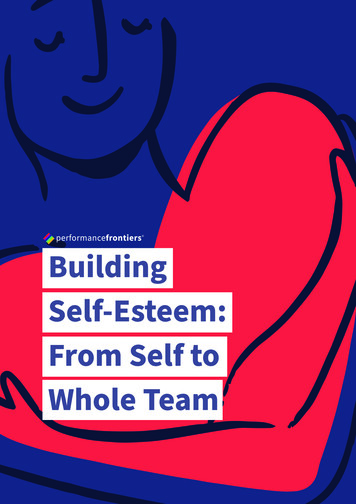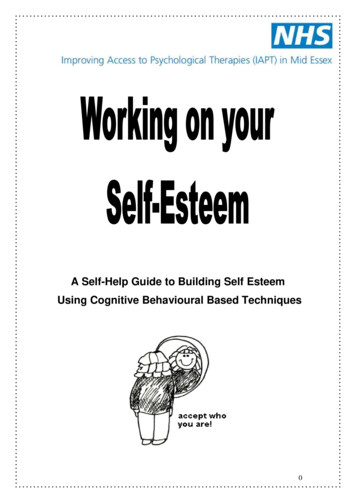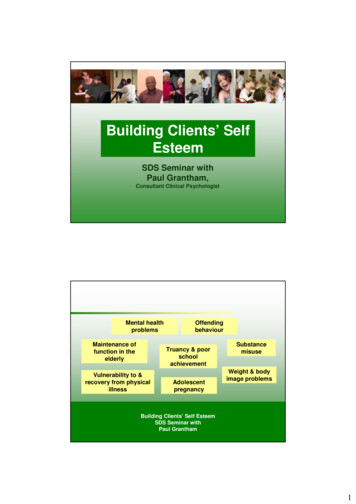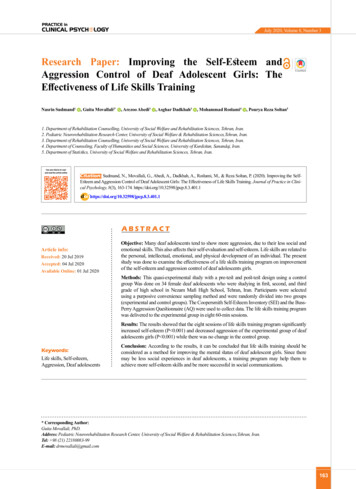
Transcription
BuildingSelf-Esteem:From Self toWhole Team
You yourself, asmuch as anybody inthe entire universe,deserve your loveand affection.- BuddhaThe Complexity ofSelf-EsteemSelf-esteem has long been the subject of self-helpbooks, leadership development programs, andorganisational training. Most of us have a senseof what the concept means but developing a trulygrounded understanding is often hijacked bypopular rhetoric.In psychology, self-esteem is seen as a globalevaluation of self-worth , or a personal evaluationof what individuals think of themselves. It is oftenregarded as a marker of psychological health.Yet, in many western cultures, high self-esteemis strongly aligned with feeling special or aboveaverage. In other words, our sense of self-worthis a comparative measure, heavily contingent onhow we live up to society’s definition of “success”.This idea seems to be supported by studies1 thatshow we are more likely to have higher selfesteem if we: outpace the achievements of our same sexparent excel in our peer groupConsider: What happens to our self-esteem if wefail to meet the standards we set by measuringourselves against our perception of others?Logically speaking, not everyone can be aboveaverage, and you are never going to be at thetop all the time. This is an inherently flawedmeasure that some experts say fosters narcissism,prejudice, and bullying tendencies. Maintaininghigh self-esteem in this paradigm becomes atreadmill of needing to be better than others tofeel okay about ourselves.We need more sustainable strategies. Copyright Performance Frontiers2
Self-CompassionPsychologist, Kristen Neff suggests that one wayto step off the self-esteem-through-comparisontreadmill is to exercise self-compassion,which means relating kindly to ourselves, andembracing our flaws.Neff explains self-compassion as a practice of: Self-kindness versus harsh self-judgement Recognising common humanity – how amI the same as others? As opposed to howam I different to others? Mindfulness – being able to sit with what is,in the present moment1Biologically though, this practice of self-criticismtaps into the body’s threat system and ourcortisol (stress) levels rise1, actively harmingenergy and performance.In contrast, practicing self-compassion increasesthe release of oxytocin and dopamine, placingus in an optimal state to do our best. Selfcompassion has been physiologically proven toimprove mental wellbeing, motivation levels, andincline us to make healthier lifestyle choices.1One of the common myths we carry about selfcompassion is that if we are too kind to ourselves,we’ll become de-motivated or lazy. So instead,we self-criticise, believing it will create energyand motivation to support high performance andsuccess.Self-compassionis there whenself-esteemdeserts you.- Kristen Neff Copyright Performance Frontiers3
The Six Pillars ofSelf-EsteemAnother way to approach the self-esteemchallenge is to completely resurface the groundupon which we measure our self-worth. Forinstance, Self-esteem expert, Nathanial Brandenproposes that self-esteem is not an idea or anaffirmation, but the practice of living our coretruths. He describes it as the “immune system ofconsciousness” which can be applied throughsix pillars3:The Practice ofLiving ConsciouslyThe Practice ofSelf-AssertivenessThe Practice ofSelf-AcceptanceThe Practice ofLiving PurposefullyThe Practice ofSelf-ResponsibilityThe Practice ofPersonal IntegrityFor which we can use the sentencecompletion game.“I will pay more attention to ”“I will be more ”Improve what you can change andaccept what you can’t.Finding power in selfdetermination "I am the authorof my thoughts and actions anddeeds. I am responsible for mypersonal happiness. No one iscoming to rescue me."Practicing self-assertiveness allowsus to live authentically, and tospeak and act from our core beliefsand values.We energise ourselves by settingattainable goals and pursuingthem.As with self-assertiveness wecommit to living our truth everyday, and in every way. Copyright Performance Frontiers4
Building Self-Esteem inan OrganisationEmployee self-esteem can have a significantimpact on how organisations function, from thequality of our relationships and culture, to thewell-being, resilience, and effectiveness of ourpeople. It is vital to be aware of how individualsare faring.Organisation-based self-esteem (OBSE) “isdefined as the degree to which an individualbelieves him/herself to be capable, significant,and worthy as an organizational member.”3Evidence of OBSE can be seen in the levelsof employee commitment, motivation, socialbehaviour, and performance, all of whichcontribute to a greater overall measure ofjob satisfaction.3The best way to assess how our team membersare feeling is to start by asking ourselves reflectivequestions: How do we support self-esteem in ourcompany? Do we seek negative qualities over positive? What rating would we give the self-esteem ofour people? Do we have a culture and processes thatencourage esteem-building?Once we have identified possible gaps orobstacles, we can begin to move towards astrategy that will build employee self-esteem inan organisational context. Although the researchinto how the mechanisms of OBSE work hasnot been extensive, there is enough informationto suggest that major sources2 of OBSE areobtained through:AutonomyThe more agency and self-expression thatindividual employees experience withinthe organisation, the more likely that areto attribute positive outcomes to their ownactions, which in turn raises their self-esteem.FeedbackOBSE is a social construct partially gleanedfrom the feedback of meaningful andsignificant others within the organisation. Letyour employees know they make a difference.ExperientialExperiences at work where we demonstratecompetency and add value will bolster selfesteem. Look to provide opportunities whereteam members can use their strengths. Thisis not to say we shouldn’t challenge or takepeople out of their comfort zones. To softenany blows that may come from negativeoutcomes, we can frame failure and mistakesas learning opportunities and a springboard togrowth.High self-esteem organisations are much morelikely to thrive in uncertain and ambiguoustimes. So right now, we can build that capacityby finding ways to give our employees moreautonomy, positive, meaningful feedback, andopportunities that will set them up for success. Copyright Performance Frontiers5
References1. 0:00 / 0:15 The Space Between Self-Esteem and Self-Compassion [Video]. (2013, February 6).https://youtu.be/IvtZBUSplr42. Self-esteem within the work and organizational context: A review of the organization-based self-esteem literature.(2004, October 1). ion/228079356 Self-Esteem Within the Work and OrganizationalContext A Review of the Organization-Based Self-Esteem Literature3. Nathaniel Branden. (n.d.). What self-esteem is and is eem-is-and-is-not Copyright Performance FrontiersSTUDIO 1, 4 Lambert Road,Indooroopilly, QLD. Australia. 4068[P] 61 7 3870 8433[E] comPlease read on screen to save paper,but if you must print, please printonly the pages you need. Copyright Performance Frontiers6
The Six Pillars of Self-Esteem Another way to approach the self-esteem challenge is to completely resurface the ground upon which we measure our self-worth. For instance, Self-esteem expert, Nathanial Branden proposes that s










